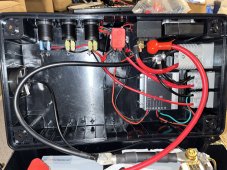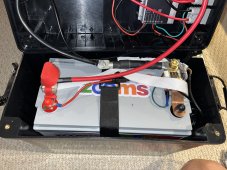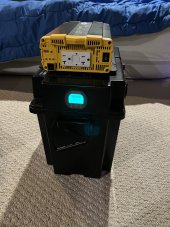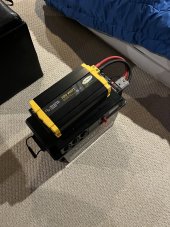Rabbit
New Member
- Joined
- Nov 19, 2019
- Messages
- 85
I don't see any other mentions of this device on this forum, so here goes...
I've-- thanks largely to Will Prowse-- been happily running a small home solar power system as a hobby for years now, and friends come to me for advice. Recently one was looking for a solar-generator type power box, so I did some fresh research in order to help. Along the way I found a radically new approach to the matter that intrigued me so much so that I bought one for myself even though I don't really need it, the Licitti Heavy Duty AC Power Box. Because it's so fundamentally different than everything else out there, I thought I'd mention it in this forum.
As I see it, this device in some ways isn't even really a solar generator at all. It looks to me like a fisherman's battery box with a solar controller and inverter added. For many years now fishermen have enclosed their trolling motor batteries in rugged, heavy-duty and specialized "battery boxes" that are often festooned with Anderson, USB, and cigarette-lighter-type power connections. The Licitti begins with this same concept and form factor, but adds a 1000-watt pure-sine inverter and a (very!) small solar controller to create a tough and (to some) "primitive" power-supply unit. All one has to do is add any standard-sized "drop-in" 12-volt lithium or even lead-acid battery to have (with one notable caveat, see below) a fairly competent solar generator. But what's even more remarkable than the ruggedness is the price. I paid about $225 (I forget the exact amount) for this thing (minus battery) delivered! (You can find a couple affiliate discount links on You Tube, if you search "Licitti" there. I don't get a dime; none of these Tubers have ever so much as heard of me.)
As near as I can tell the Licitti works great (and I'm certainly much happier with it than at least one and maybe both of my two Bluettis). Setup was idiot-easy, I've been able to pull 1100 watts sustained from the supposed 1000 watt inverter, and the display (while small and extremely primitive) does all it really (IMO) needs to. Bluetooth? Don't make me laugh. This device is the very best of bare-bones basic; the simplicity and lack of frills is one of its most powerful virtues. The Licitti adds very little weight to the battery, so this is about as light and portable as a 1200 watt-hour solar generator is ever going to be. But the main reason I like it so much (other than the super-good price!) is that it's designed for how I actually want to use a portable power station in the real world. There are multiple Anderson connections, for example, including one 175-amp plug that I can use to attach another battery (or even a daisy-chain of batteries) for more capacity, _very_ cheaply. I can also use this same socket to connect the unit's battery into my current home-solar setup's battery bank, so that I'm getting value out of the most expensive component of the system (the battery) every single day. In fact, setting things up this way even makes another 1000-watt inverter available in the home system at the push of a button. If my battery goes bad the Licitti will still work just fine with another one, or if the Licitti goes bad I still have a perfectly good drop-in battery-- try that with any other solar generator. With them, generally, if any one component goes bad you can't easily replace it. I mentioned the tiny, primitive display earlier. My take is that I can worry less about the device banging around in the back of my truck, because the display (being so small) is much less likely to take an unlucky impact and shatter than on a more conventional solar generator. Being based on a fishing-boat lineage, the Licitti is innately _much_ more robust than most designs. The casing is designed for a degree of abuse, unlike the delicate "mainstream" style of solar generators. I think you could wallop this thing with a hammer a time or three in a lot of places and the only damage would be scuffing.
There is one important for-sure caveat and one potential caveat I must mention here. The for-sure caveat is that, as delivered, the Licitti can be charged only by a solar panel inputting into its tiny, 100-watt capacity controller. (They say it's an MPPT, but I've never tried mine.) If you want to charge any other way you have to provide your own external charger, which can be plugged very conveniently into the multiple Anderson connectors provided. (Or, you can just attach another battery of the same chemistry via the 175 Anderson and charge _it_.) I already owned both a small AC and DC to DC charger fitted with Andersons, so for me this was not a significant problem. Or you could use another larger solar controller and an Anderson to attach however many panels you like right up the battery's capacity to accept charging. (Or then use the 175-amp Anderson to attach more batteries and charge them as well, if you like. This setup is _flexible_.) Again I see this absence of internal chargers as at least in some ways an advantage, as if a charger fails it's easily replaced instead of crippling the whole unit. The other potential concern I have is really an unjustified one, that I hope someone who reads this and buys a Licitti will remedy for me. This unit costs only around $200, and even "naked" pure-sine 1000-watt inverters cost a lot these days. Is the inverter actually pure sine, as claimed? I have absolutely no reason to doubt Licitti's word on this. Everything they've claimed that I'm equipped to verify checks out, and I corresponded a bit with their US rep via e-mail over a shipping issue and was treated exceptionally well and courteously. I don't own a scope, however, and know of no other way to verify for sure that the inverter is pure-sine. Nor have any You Tubers to date, that I'm aware of. In my personal usage it's pretty easy for me to simply treat it like it's not, however, so that's what I'm doing until I can find a way to make sure.
Bottom line... I love this thing for its ruggedness, simplicity, light weight, versatility, modularity, low cost, and perhaps most of all because I can link it into my existing battery bank and get continual daily use out of my investment. It's also perfect to toss into the back of my truck while traveling or doing work that might require AC power, and has become perhaps my favorite solar-toy to date. I've only lightly used it so far, but it's so cheap that if I get two years out of it (and the battery is still good, which it should be) I'll have zero reason for complaint. I only hope they'll someday come out with a version that's got a 2000 watt inverter. That would be even better.
I've-- thanks largely to Will Prowse-- been happily running a small home solar power system as a hobby for years now, and friends come to me for advice. Recently one was looking for a solar-generator type power box, so I did some fresh research in order to help. Along the way I found a radically new approach to the matter that intrigued me so much so that I bought one for myself even though I don't really need it, the Licitti Heavy Duty AC Power Box. Because it's so fundamentally different than everything else out there, I thought I'd mention it in this forum.
As I see it, this device in some ways isn't even really a solar generator at all. It looks to me like a fisherman's battery box with a solar controller and inverter added. For many years now fishermen have enclosed their trolling motor batteries in rugged, heavy-duty and specialized "battery boxes" that are often festooned with Anderson, USB, and cigarette-lighter-type power connections. The Licitti begins with this same concept and form factor, but adds a 1000-watt pure-sine inverter and a (very!) small solar controller to create a tough and (to some) "primitive" power-supply unit. All one has to do is add any standard-sized "drop-in" 12-volt lithium or even lead-acid battery to have (with one notable caveat, see below) a fairly competent solar generator. But what's even more remarkable than the ruggedness is the price. I paid about $225 (I forget the exact amount) for this thing (minus battery) delivered! (You can find a couple affiliate discount links on You Tube, if you search "Licitti" there. I don't get a dime; none of these Tubers have ever so much as heard of me.)
As near as I can tell the Licitti works great (and I'm certainly much happier with it than at least one and maybe both of my two Bluettis). Setup was idiot-easy, I've been able to pull 1100 watts sustained from the supposed 1000 watt inverter, and the display (while small and extremely primitive) does all it really (IMO) needs to. Bluetooth? Don't make me laugh. This device is the very best of bare-bones basic; the simplicity and lack of frills is one of its most powerful virtues. The Licitti adds very little weight to the battery, so this is about as light and portable as a 1200 watt-hour solar generator is ever going to be. But the main reason I like it so much (other than the super-good price!) is that it's designed for how I actually want to use a portable power station in the real world. There are multiple Anderson connections, for example, including one 175-amp plug that I can use to attach another battery (or even a daisy-chain of batteries) for more capacity, _very_ cheaply. I can also use this same socket to connect the unit's battery into my current home-solar setup's battery bank, so that I'm getting value out of the most expensive component of the system (the battery) every single day. In fact, setting things up this way even makes another 1000-watt inverter available in the home system at the push of a button. If my battery goes bad the Licitti will still work just fine with another one, or if the Licitti goes bad I still have a perfectly good drop-in battery-- try that with any other solar generator. With them, generally, if any one component goes bad you can't easily replace it. I mentioned the tiny, primitive display earlier. My take is that I can worry less about the device banging around in the back of my truck, because the display (being so small) is much less likely to take an unlucky impact and shatter than on a more conventional solar generator. Being based on a fishing-boat lineage, the Licitti is innately _much_ more robust than most designs. The casing is designed for a degree of abuse, unlike the delicate "mainstream" style of solar generators. I think you could wallop this thing with a hammer a time or three in a lot of places and the only damage would be scuffing.
There is one important for-sure caveat and one potential caveat I must mention here. The for-sure caveat is that, as delivered, the Licitti can be charged only by a solar panel inputting into its tiny, 100-watt capacity controller. (They say it's an MPPT, but I've never tried mine.) If you want to charge any other way you have to provide your own external charger, which can be plugged very conveniently into the multiple Anderson connectors provided. (Or, you can just attach another battery of the same chemistry via the 175 Anderson and charge _it_.) I already owned both a small AC and DC to DC charger fitted with Andersons, so for me this was not a significant problem. Or you could use another larger solar controller and an Anderson to attach however many panels you like right up the battery's capacity to accept charging. (Or then use the 175-amp Anderson to attach more batteries and charge them as well, if you like. This setup is _flexible_.) Again I see this absence of internal chargers as at least in some ways an advantage, as if a charger fails it's easily replaced instead of crippling the whole unit. The other potential concern I have is really an unjustified one, that I hope someone who reads this and buys a Licitti will remedy for me. This unit costs only around $200, and even "naked" pure-sine 1000-watt inverters cost a lot these days. Is the inverter actually pure sine, as claimed? I have absolutely no reason to doubt Licitti's word on this. Everything they've claimed that I'm equipped to verify checks out, and I corresponded a bit with their US rep via e-mail over a shipping issue and was treated exceptionally well and courteously. I don't own a scope, however, and know of no other way to verify for sure that the inverter is pure-sine. Nor have any You Tubers to date, that I'm aware of. In my personal usage it's pretty easy for me to simply treat it like it's not, however, so that's what I'm doing until I can find a way to make sure.
Bottom line... I love this thing for its ruggedness, simplicity, light weight, versatility, modularity, low cost, and perhaps most of all because I can link it into my existing battery bank and get continual daily use out of my investment. It's also perfect to toss into the back of my truck while traveling or doing work that might require AC power, and has become perhaps my favorite solar-toy to date. I've only lightly used it so far, but it's so cheap that if I get two years out of it (and the battery is still good, which it should be) I'll have zero reason for complaint. I only hope they'll someday come out with a version that's got a 2000 watt inverter. That would be even better.
Last edited:







